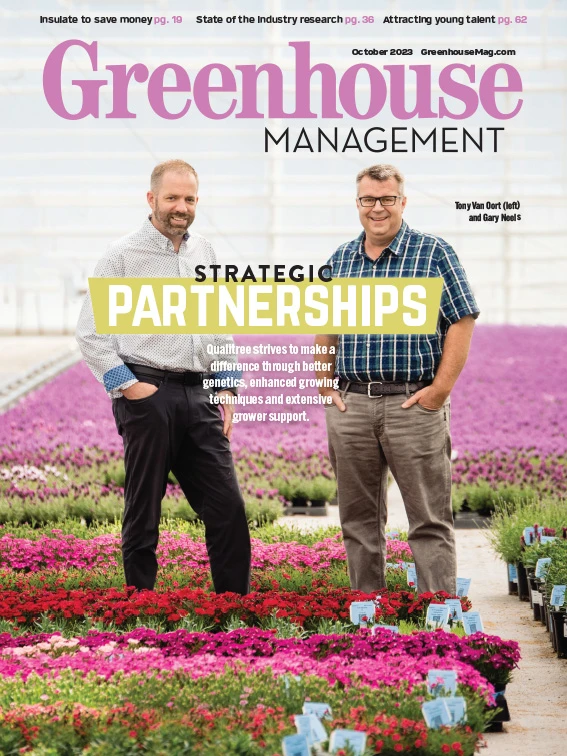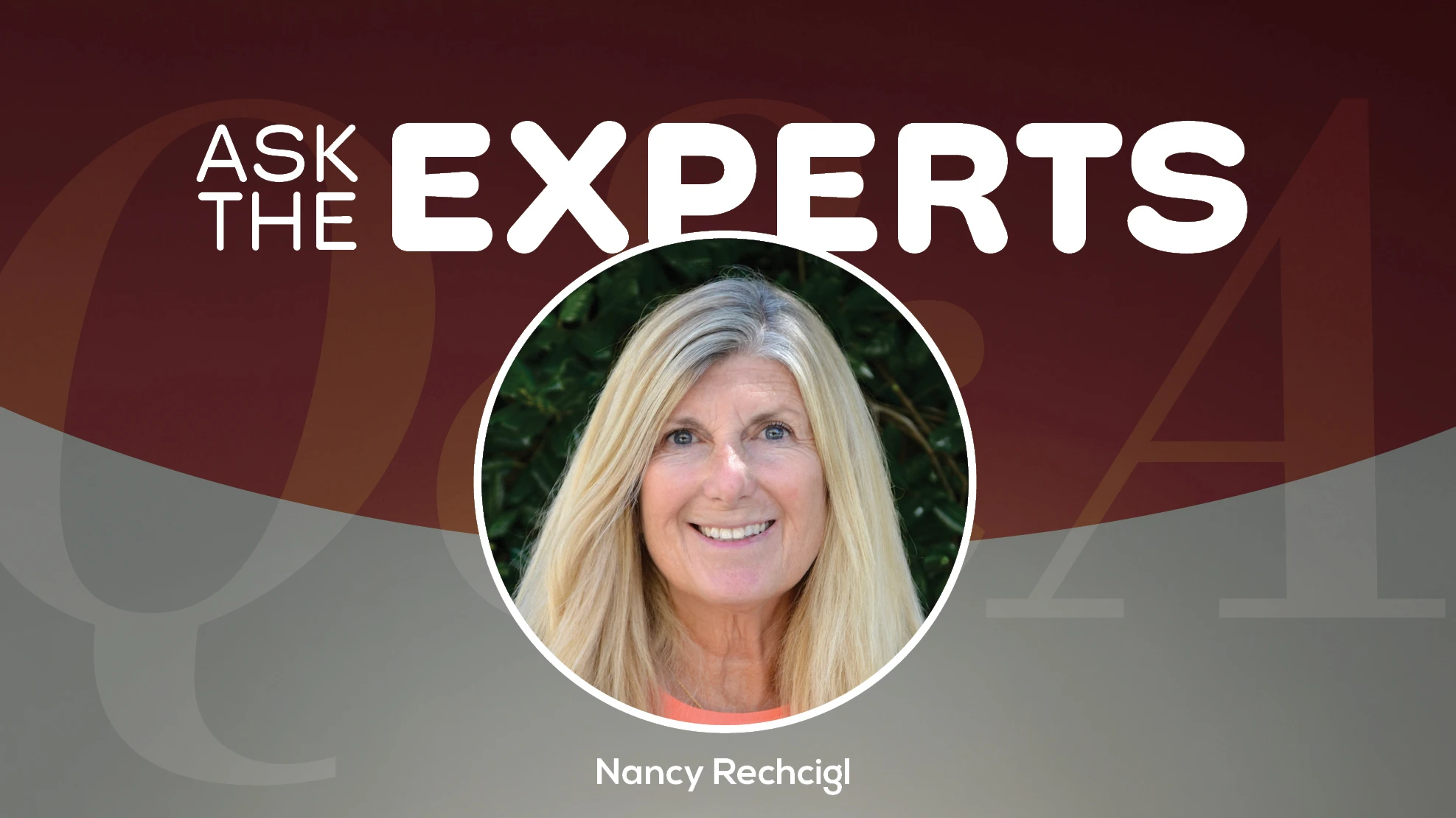
Pots of hydrangea line the benches of a hoop house under shade cloth near Athens, Georgia. These are the best of the best, the potential mothers and fathers of the next great hydrangea to come from Bailey Innovations.
David Roberts supervises the collection of pollen and seed, as plant breeders armed with tweezers and petri dishes perform their careful crosses. David is director of plant breeding at Bailey Innovations, the in-house product development division of Bailey. The family-run multi-state nursery is known for brands like Endless Summer hydrangeas, First Editions trees and shrubs and Easy Elegance roses. David has led the breeding program at Bailey Innovations since it opened the Winterville, Georgia, location in 2018.
“When I went to school, it just seemed like such a cool idea to be able to invent a plant,” David says. “That concept was just very foreign to me.”
He’s been involved in all of their plant introductions over the past six years. If it hit the market from one of the Bailey brands, he’s probably trialed it. But Eclipse is the first introduced plant that is wholly his work, from start to finish.
It was the dream he had ever since he started breeding plants. But there are so many steps that had to happen for that dream to become reality. So much has to go right for a new plant to make it to market. To have a breeding idea and get to see it through. To have the plant do exactly what you hoped it would do. To have it pan out at a level that it was good enough to trial. To have it perform so well in the trials that it was welcomed into the brand.
“They even let me name it and everything,” he says. “It's literally the whole nine yards.”
He’s rightfully proud. He knows this doesn’t happen often. But he won’t take all the credit.
“I’ve had a whole team help me get this plant across the finish line,” Roberts says. “But just to have a hand in every step along the way…it’s one of the greatest honors of my life. It’s what I got into this for.”
A chance to be special
David had high hopes for the hydrangea that would become Eclipse ever since he saw that dark purple foliage. But he had to keep his expectations in check. He’d seen enough plants show an amazing trait once. Now if he could make that plant do it every time, that’s a completely different story. He knew it would need to repeat that performance many, many times before he could count on it happening consistently.
When Eclipse made it through the second round of cutbacks and still kept the purple foliage, that was when he knew this plant could be something special. That was 2019, after the second year of production trials. At that point, it had maintained the signature purple foliage for two years in a row. That was a crucial step because for a plant to be worthy of an introduction, you need to prove that whatever makes it special will occur consistently, without fail, for not just one year, but multiple years.
After the second full year of production trials, which was 2019, David made his pitch for Eclipse to the Bailey new variety committee. Everyone knows how much time, money and effort goes into a new introduction, so the only plants that even make it to this step are the ones that have passed every test the breeders have in place. David and his team have years of data to back up their assertion that this plant will succeed.
“After they looked at the data and saw the plant for themselves, they came to the same conclusion,” he says. “You can stand up and say ‘Take my word for it’ all you want, but when you’ve got numbers that can back you up, that usually speaks for itself. That’s what we try to rely on more than anything. Let the data do the talking and if it’s a great plant then the data will reflect that.”
He’s particularly proud of the fact that through all its tests, Eclipse has never had any type of mildew, even when placed in a row can-tight with infected plants.
Selection for success
The breeders divide plants into several categories based on which desirable trait they’ve shown. Like a recessive gene, certain traits are less likely than others to keep through generations, which makes those traits more difficult to breed into new plants.
Some traits David and his crew breed to isolate are double flowers, true white or true red colors, stem strength and foliage color.
Some of the most stunning flowers that occur in hydrangea are “picotee” flower. This type of flower is when a dark sepal color has a white perimeter around the margin of the flower. Sometimes the white margin is thin, sometimes it’s thick. Sometimes the breeders will combine a picotee hydrangea with a double-flowering hydrangea to increase the number of those appealing flowers.
The result is visually striking, but it’s also very difficult to breed for picotee because that white margin typically doesn’t stay bright white long before turning brown. The breeding challenge is creating a flower with a strong white margin that stays protected throughout the growing season.
Another breeding challenge is stem strength. David and his team have created some hydrangea with truly gigantic mophead blooms, but they’ll never be introduced to the market if those heads are laying down on the ground because the stems can’t support their weight.
Rows and rows of containers are grouped based on those categories. The breeders place purple or blue flags in the pots of the best examples of their category. These may be studied more closely, used as parents for more crosses, or move on to another round of evaluations. Other pots have red flags placed in them, denoting a literal “red flag” of some sort. By the end of October, the house will be empty, but the red flags help the crew thin the herd earlier.
Once the best seedlings are selected, they go through propagation trials to ensure the plants are viable for growers. In-ground and container trials take place across the country to ensure garden and landscape performance for the end consumer.
The growers know
Bailey has licensees across the U.S. and several Canadian provinces. Florida-based Tropic Traditions currently grows on over 130 acres in four locations in Alachua County. The nursery produces a wide variety of native and coastal trees and shrubs and has one of the largest inventories of cold-hardy palms in the Southeast. Tropic Traditions ships all over the Southeastern U.S. as well as to some parts of Canada.
Jim Fleming, owner and president of Tropic Traditions has been one of Bailey’s network growers for at least 10 years, he says. He also grows branded plants for Southern Living, Star Roses and Plants, Black Diamond Crape Myrtles and Encore Azaleas.
“If I think it’s a good plant that I’m going to be able to sell, I try to jump on it and get my liners immediately so I can get it in production,” he says.
At Tropic Traditions, Jim sells a lot of First Editions material in large containers. For instance, he has Flip Side vitex available in a 45-gallon pot. It’s a niche that his nursery has become known for in the market, growing larger container material of branded products.
The partnership works well, he says. He helps Bailey by trialing their plants in the sweltering Florida heat and they help him by providing a solid plant his customers will buy. Also, when he attends Bailey network grower meetings in Minnesota or Oregon, he usually comes away with a few ideas to improve his own operation. After trialing their latest selection, he was exceedingly impressed by Eclipse.

“I own a patent on another plant; I’ve been growing plants all my life,” Jim says. “And when I saw this, I said, ‘Oh man, this is going to be a good one.’ This is the first dark leaf hydrangea I’ve ever seen that holds its color. That’s why with Eclipse I think they hit such a home run. Everybody likes that dark color.”
He received his liners Aug. 15, planted them Aug. 24, mixed in NutriCoat 1868 in the soil. The crop was ready to move up April 12. So in the Zone 8-B Florida climate, Eclipse went from liner to a 3-gallon, fully rooted and ready to go in eight months. Once he became reasonably confident about that, he asked for liners. His batch of liners were heading out of production in early June when we spoke. Now that they’ve determined it takes eight months in his climate, after propagation, Jim strategically planned to move plants from 3-gallon pots to 7-gallon pots, allowing him to hit the market with 3s and 7s, available now.
One of Jim’s most important jobs as a trial grower is to test the heat tolerance of new genetics. As one of Bailey’s most Southern grower partners, he needs to stringently test the plant against that legendary Georgia heat and humidity.
Jim says the hydrangea is holding up well in the 55% shade area of the nursery with an 80% pine and 20% compost growing mix. As part of the trial agreement, he emails data back to Bailey telling them how the plant is performing. He looks for how fast it grows, whether it has any pest issues, how much water and shade it likes.
“They test and they test and they test and they don’t release until they know it’s going to work,” Jim says.
On the other side of North America in Kelowna, British Columbia, Canada, Bylands Nursery treats a plant being trialed like any other plant of the same genus, and the plant needs to fit into their production. Mike Byland, vice president and general manager of Bylands Nursery, explains that the plant needs to be better than what’s already in the market and have new positive attributes. It also needs to propagate well because if a plant doesn’t propagate well, it’s really difficult to add it to the production line.
“We don’t usually do a lot of trialing, but we jumped in with this plant because we have a lot of experience with macrophylla hydrangeas,” Mike says. “We thought this specific variety was very unique and showed a lot of potential compared to what’s on the market, so we felt strongly about proceeding with it.”
Bylands Nursery started trialing and growing Eclipse in the late summer of 2022 and plan to start selling Eclipse in the spring of 2024. That’s around a 15-month turnaround which is a normal turnaround for them when trialing plants.
“Eclipse has been a really good plant so far,” Mike says. “It’s a good grower, and it’s been a good production plant. The foliage really stands out. It’s such a dark color. It’s definitely the darkest macrophylla hydrangea on the market. So far, it’s proven to handle a tough, cold winter, and it’s been holding up in the heat because we’ve had a really hot spring.”
When trialing a plant, Mike explains that communication with the breeder is key for the grower partners to succeed. It takes strong support from the breeder and plant introducer to really help the grower bring the plant to market because both the growers and breeders are all working with tight time frames. Having the support and information from the breeder or plant introducer, who has multiple years of experience with the plant, is critical in being able to successfully introduce a plant across North America for a launch.

Since Bailey is a breeder, brand owner and a grower, they are in a similar situation as their grower partners.
“We are essentially giving the growers the same information and experiences that we’ve had with the plants to help them succeed,” says Layci Gragnani, brand and business development manager at Bailey.
Trialing is imperative to Matt Richards, COO of Clinton Nurseries, before he’ll agree to grow and sell any new plant. Being new isn’t good enough, he says. It’s got to pass the production test: was it easy to grow? It’s also got to pass the distinctiveness test: will it catch the eye of consumers and end up in a shopping basket?“Before we buy any liners or add any new plants to production, we look at color, texture and shape. That new plant has got to really catch your eye,” Matt says. “And if it’s an improved variety, then we ask if there’s better disease resistance or cold hardiness and if the growth habit has improved. We’re selling to big-box stores, so we’re shipping tractor-trailer loads full of plants. Those plants have to first do well for us in production and second help our customers differentiate themselves.”
Matt says his breeder-grower relationships are a two-way street and each party provides crucial feedback to one another. Matt first saw Eclipse in the trial garden during a visit to Bailey Innovations two years ago.
“When I saw the foliage color and how the flower color contrasted with the dark foliage, it really caught my eye,” Matt recalls. “I was also interested in Eclipse because that foliage color will give it a longer shelf life. Retailers can sell it for the foliage color and the flower.”
Matt’s team at Clinton’s Connecticut location put some in a production trial.
“We knew that if it did well in Georgia, we didn’t need to test it at our Florida location,” he explains. “So we wanted to see how it would do in the Connecticut environment. We did absolutely nothing to them and they turned out really nice. So we got really excited about it.”
Now that Eclipse is officially in production for Clinton, so far, the plants have only needed a trim and the typical fertilizer application their other flowering shrubs receive, he says.
“That’s a winner in our book,” he adds.
Long and winding road
The path Eclipse took to become the latest hydrangea from the First Editions brand was long and arduous. Seed was initially sown in the summer of 2016, collected in the fall and germinated in winter. As the calendar flipped to 2017, seedlings were selected for their dark foliage color and transplanted to 32-cell trays, then promoted to 3-gallon containers in late spring.
That summer, the hydrangea that would become Eclipse was selected for its dark leaf color and cranberry mophead flowers. It was flagged for continued observation. In June 2018, it was cut back to about 3-4 inches above the container rim. This test measures how well a hydrangea reblooms. Despite the summer heat and the chop, Eclipse’s signature dark foliage remained.
More tests arrived in 2019. Time to full bloom, time to finish and true hardiness were just a few. In spring 2020, Eclipse survived the Minnesota winter and continued trials in Georgia. At this point, marketing and branding plans were made. More trials were done around the country with grower partners. In 2021, comparison trials began matching Eclipse up against other hydrangea that have similar characteristics – in this case, claims of dark purple foliage. Throughout 2022 more preparations were made, as well as the overwintering test.
This year, more trials took place. Also grower partners began building up numbers of the plant ahead of its official launch to the trade, which occurred at Cultivate’23. Efforts continue to build for a 2024 national release.
Get curated news on YOUR industry.
Enter your email to receive our newsletters.
Explore the October 2023 Issue
Check out more from this issue and find your next story to read.
Latest from Greenhouse Management
- pH Helpers
- Society of American Florists accepting entries for 2025 Marketer of the Year Contest
- Sustainabloom launches Wholesale Nickel Program to support floriculture sustainability
- American Horticultural Society welcomes five new board members
- Color Orchids acquires Floricultura Pacific, becoming largest orchid supplier in U.S.
- American Floral Endowment establishes Demaree Family Floriculture Advancement Fund
- The Growth Industry Episode 3: Across the Pond with Neville Stein
- 2025 State of Annuals: Petal power






